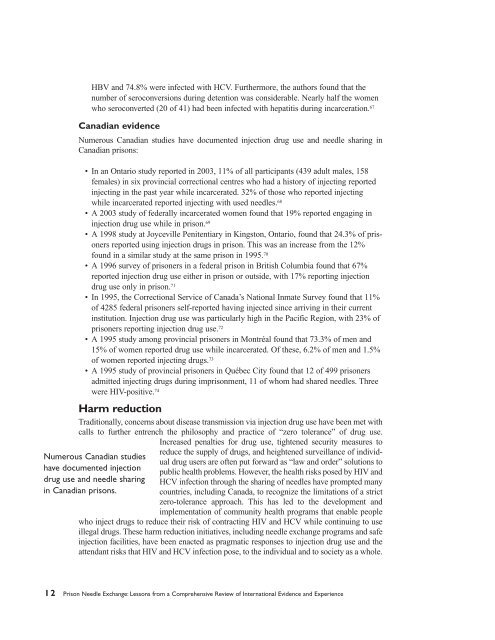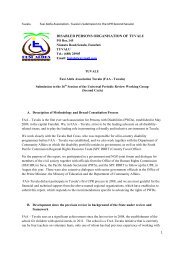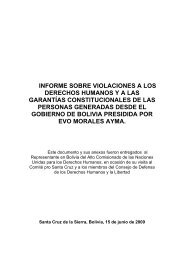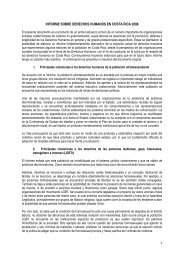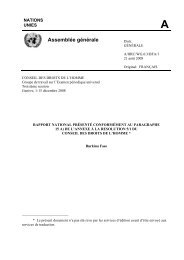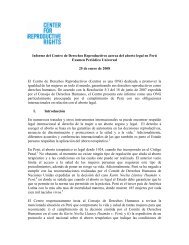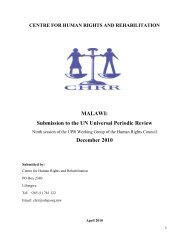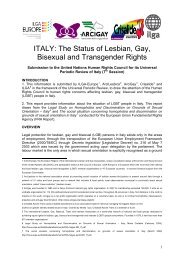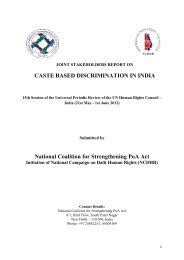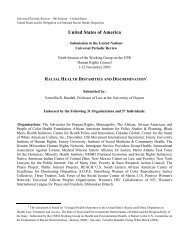Prison Needle Exchange: Lessons from a Comprehensive Review ...
Prison Needle Exchange: Lessons from a Comprehensive Review ...
Prison Needle Exchange: Lessons from a Comprehensive Review ...
Create successful ePaper yourself
Turn your PDF publications into a flip-book with our unique Google optimized e-Paper software.
HBV and 74.8% were infected with HCV. Furthermore, the authors found that the<br />
number of seroconversions during detention was considerable. Nearly half the women<br />
who seroconverted (20 of 41) had been infected with hepatitis during incarceration. 67<br />
Canadian evidence<br />
Numerous Canadian studies have documented injection drug use and needle sharing in<br />
Canadian prisons:<br />
• In an Ontario study reported in 2003, 11% of all participants (439 adult males, 158<br />
females) in six provincial correctional centres who had a history of injecting reported<br />
injecting in the past year while incarcerated. 32% of those who reported injecting<br />
while incarcerated reported injecting with used needles. 68<br />
• A 2003 study of federally incarcerated women found that 19% reported engaging in<br />
injection drug use while in prison. 69<br />
• A 1998 study at Joyceville Penitentiary in Kingston, Ontario, found that 24.3% of prisoners<br />
reported using injection drugs in prison. This was an increase <strong>from</strong> the 12%<br />
found in a similar study at the same prison in 1995. 70<br />
• A 1996 survey of prisoners in a federal prison in British Columbia found that 67%<br />
reported injection drug use either in prison or outside, with 17% reporting injection<br />
drug use only in prison. 71<br />
• In 1995, the Correctional Service of Canada’s National Inmate Survey found that 11%<br />
of 4285 federal prisoners self-reported having injected since arriving in their current<br />
institution. Injection drug use was particularly high in the Pacific Region, with 23% of<br />
prisoners reporting injection drug use. 72<br />
• A 1995 study among provincial prisoners in Montréal found that 73.3% of men and<br />
15% of women reported drug use while incarcerated. Of these, 6.2% of men and 1.5%<br />
of women reported injecting drugs. 73<br />
• A 1995 study of provincial prisoners in Québec City found that 12 of 499 prisoners<br />
admitted injecting drugs during imprisonment, 11 of whom had shared needles. Three<br />
were HIV-positive. 74<br />
Harm reduction<br />
Traditionally, concerns about disease transmission via injection drug use have been met with<br />
calls to further entrench the philosophy and practice of “zero tolerance” of drug use.<br />
Increased penalties for drug use, tightened security measures to<br />
reduce the supply of drugs, and heightened surveillance of individual<br />
drug users are often put forward as “law and order” solutions to<br />
public health problems. However, the health risks posed by HIV and<br />
HCV infection through the sharing of needles have prompted many<br />
countries, including Canada, to recognize the limitations of a strict<br />
zero-tolerance approach. This has led to the development and<br />
implementation of community health programs that enable people<br />
who inject drugs to reduce their risk of contracting HIV and HCV while continuing to use<br />
illegal drugs. These harm reduction initiatives, including needle exchange programs and safe<br />
injection facilities, have been enacted as pragmatic responses to injection drug use and the<br />
attendant risks that HIV and HCV infection pose, to the individual and to society as a whole.<br />
Numerous Canadian studies<br />
have documented injection<br />
drug use and needle sharing<br />
in Canadian prisons.<br />
12 <strong>Prison</strong> <strong>Needle</strong> <strong>Exchange</strong>: <strong>Lessons</strong> <strong>from</strong> a <strong>Comprehensive</strong> <strong>Review</strong> of International Evidence and Experience


